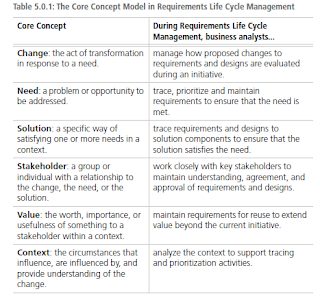Requirement Life Cycle Management.
The knowledge area which depicts the jobs that B.A's undertook in order to manage, organize and maintain requirements and designs information from inception to retirement.
These jobs maintains meaningful relationships between connected requirements and designs.
The purpose of Requirement Life Cycle Management is to make sure that the business, stakeholder, and solution requirements and designs aligned to each other and that the solution implements them. It also helps to ensure that business analysis is available for future use.
The Requirements Life Cycle:
- Starts with representation of a business need as a requirement.
- Continue through the development of a solution.
- Ends when a solution and the requirements that represent it are retired.
The management of requirements does not end once a solution is implemented. Throughout the life of a solution, requirements continue to provide importance when they are managed appropriately also requirements may be in multiple states at one time.
The Requirements Life Cycle Management knowledge areas include following tasks:
Trace Requirements: analyzes and maintains the relationships between
requirements, designs, solution components, and other work products for
impact analysis, coverage, and allocation.
• Maintain Requirements: make sure that requirements and designs are
accurate and current throughout the life cycle and facilitates reuse where
needed.
• Prioritize Requirements: assesses the value, urgency, and risks associated
with particular requirements and designs to ensure that analysis and/or
delivery work is done on the most important ones at any given time.
• Assess Requirements Changes: evaluates new and changing stakeholder
requirements to determine if they need to be acted on within the scope of a
change.
• Approve Requirements: works with stakeholders involved in the
governance process to reach approval and agreement on requirements and
designs.
Trace Requirements: analyzes and maintains the relationships between
requirements, designs, solution components, and other work products for
impact analysis, coverage, and allocation.
• Maintain Requirements: make sure that requirements and designs are
accurate and current throughout the life cycle and facilitates reuse where
needed.
• Prioritize Requirements: assesses the value, urgency, and risks associated
with particular requirements and designs to ensure that analysis and/or
delivery work is done on the most important ones at any given time.
• Assess Requirements Changes: evaluates new and changing stakeholder
requirements to determine if they need to be acted on within the scope of a
change.
• Approve Requirements: works with stakeholders involved in the
governance process to reach approval and agreement on requirements and
designs.
Core Concepts Model in Requirements Life Cycle Management
Trace Requirements
Purpose: The purpose of Trace Requirements is to make sure that needs and designs at different levels are aligned to each other, and to manage the effects of change to one level on related requirements.
Description: Requirements tractability identifies and documents the lineage of each
requirement, including its backward tractability, its forward tractability, and its
relationship to other requirements.
Trace ability enables:
• Faster and simpler impact analysis.
• More dependable discovery of inconsistencies and gaps in needs.
• Deeper insights into the scope and complexity of a change.
• Reliable assessment of which needs have been addressed and which
have not.





Requirement life-cycle involves many phases and sometimes times it is really complicated process. Each phase have different requirements. However, with the BABOK and the content above has really made it helpful to understand what a Business Analyst needs to do for Requirement life-cycle management and how the process can be traced.
ReplyDeleteLife cycle management is a business management approach that can be used by all types of small and big businesses to improve their sustainability performance. Its purpose is to ensure more sustainable value chain management. LCM is useful for the organisation to target, organize, analyze and manage product-related information and activity.
ReplyDeleteRequirement life-cycle represent a business need according to requirement, as well as it helps through the development of a solution. Requirement life cycle management works through Trace requirement, maintain requirement, prioritize requirement, assess requirements changes and approve requirements.
ReplyDelete